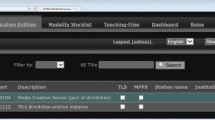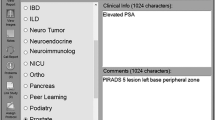Summary
The MEDISYS program runs on IBM-compatible microcomputers equipped with a disk operating system (MicroSoft, MS/DOS) as well as in a local network. It enables direct input of data in real time using mnemonic codes and provides the urologist with complete computerized files, statistical analysis, and automatically written reports. The integration of a videoframe grabber makes the images directly available on the computer display, like other data. Input of the images can be achieved either directly from the imaging device [e.g., ultrasound (US), computerized tomographic (CT) scan] or by using a small video camera for transparent film and paper images [e.g., US, Magnetic Resonance Imaging (MRI), scintigraphy]. The images are saved and classified according to their type [e.g., intravenous pyelogram (IVP), US]; their date; and their codes, indicating diagnosis, possible previous treatment, and the main pathologic features indicated by the image. These images, which can be modified through various functions, are available not only in the patient's file, from which they can be displayed within a few seconds, but also in an image bank that can be analyzed, which constitutes a new and powerful tool for teaching. The cost of the equipment remains moderate.
Similar content being viewed by others
Author information
Authors and Affiliations
Rights and permissions
About this article
Cite this article
Camey, M., Camey, T. Computer use in filing urological images and data by MEDISYS. World J Urol 8, 140–142 (1990). https://doi.org/10.1007/BF01576759
Issue Date:
DOI: https://doi.org/10.1007/BF01576759




